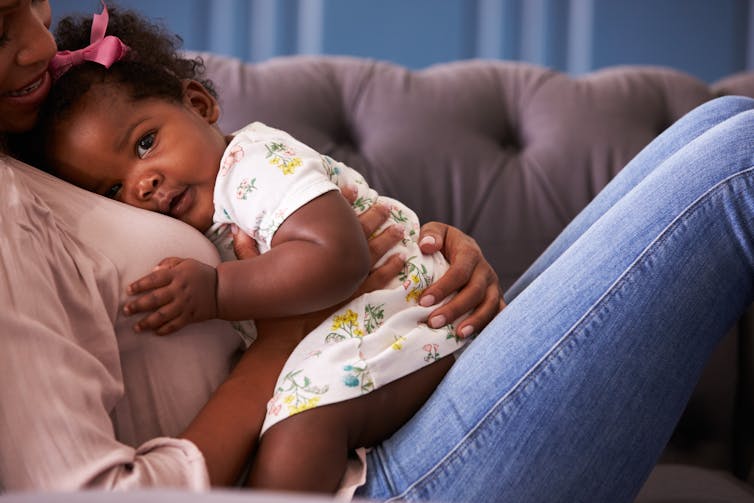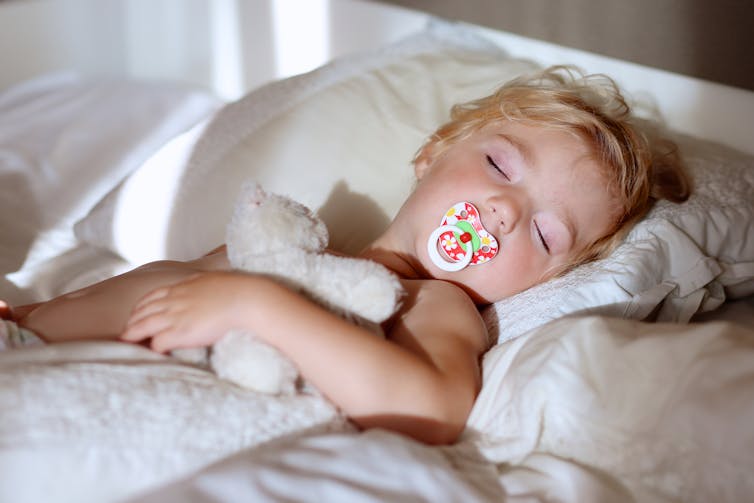How Is a Baby Secure When He's With His Favorite Toy
Many parents volition feel a twinge of concern if their five-year-old tin't sleep without his dummy or their teenager refuses to throw out the tattered blanket she's had since she was a babe. The topic of comfort objects is hotly debated, with some arguing that the zipper to objects from babyhood is childish, unnecessary or even harmful.
And so when should yous worry well-nigh your child's reliance on comfort items? And how tin can you encourage them to allow get?
The truth is that even adults have attachment objects. How many get comfort from a favourite jumper? Or hoard treasured objects from loved ones without second idea? Subsequently all, a third of adults admit they can't bear to part with their ain moth-eaten childhood toy.
A demand for condolement is part of existence human, and condolement objects remind u.s.a. of feeling calm, secure and loved. Babies are built-in wanting to exist held close. They spend months cuddled and swayed, knowing someone will help soothe their needs. This helps them build feelings of secure zipper to a parent and conviction to go out into the world.
And one solar day they must brand that journey – whether to childcare, school or even merely across the room when they beginning to crawl. A parent tin't always be at that place to comfort them, but something that reminds them of that security can – a comforter, or, in scientific terms, a "transitional object" that bridges a link between a new situation and the comfort of home.
Although research in the 1940s considered such items a sign of poor attachment, the paediatrician and psychoanalyst Donald Winnicott later proposed that they were in fact the opposite. Rather than beingness an object to turn to in lieu of love and care, they were a reminder of love and security.
Although most children abound out of comfort objects by the age of four, later inquiry has continued to support Winnicott. One study found that kids with potent bonds to transitional objects have stronger zipper to a parent and are happier than those without.

Merely this upshot starts to reverse as children go older. The same report showed that teens who nonetheless hold a stiff zipper to a transitional object accept poorer mental health. While there is nothing wrong with keeping a comfort blanket for the addicted memories it brings, notwithstanding needing it on a mean solar day to day basis as a teenager, or indeed as an adult, could be a sign that something is incorrect.
Dummies and bottles
Some comfort objects, however, are better than others. The prove for using dummies (pacifiers) or bottles past 12 months is less positive. Similarly, although babies pollex suck in the womb, if this habit is carried on by a year, problems tin arise.
Babies are born with an innate need to suck. When breastfeeding, sucking feeds them, calms them and increases the mother'southward milk supply. Dummies can help bottle-fed babies to suck and calm themselves. Sometimes breastfeeding mums use them, but if a babe meets its sucking needs elsewhere, this can reduce milk supply, so they aren't recommended in the first six weeks.
The field of study of whether to give a baby a dummy or not can be divisive. If used carefully, they can take some benefits for young babies and are recommended at nighttime as they may reduce adventure of Sudden Infant Death Syndrome, perhaps because they terminate a baby sleeping too deeply. Sucking can also sometimes help a infant with colic.
But experts recommend babies should exist weaned from dummies after six months. Aside from the claiming of weaning an older baby, dummies can introduce harmful bacteria into the mouth. They can also increase the risk of ear infections, and even affect how teeth come through. Oral communication development can also be delayed as babies miss out on early voice communication practice and mispronounce words every bit a dummy is in the way.

Allowing children to have a bottle for comfort is likewise a bad idea. Bottles are naturally associated with comfort due to the combination of food, sucking and existence held close. Only babies should be slowly weaned off them once they are eating solid foods and stopped by 12 months. When a baby sucks on a canteen the milk pools around their teeth and can cause cavities. Bottles can too have a like impact to dummies on spoken communication development and teeth.
The aforementioned does not apply to breastfed babies. There is a lot of difference in pliability between a nipple and a dummy or bottle, meaning less impact on jaw and tooth development. Nipples are also not kept in the mouth for extended periods. Finally, breastmilk is delivered to the back of the mouth rather than milk pooling effectually the front end teeth meaning a lower risk of cavities. So those who squirm at the thought of breastfeeding past infancy but encourage a dummy are not only confused in their logic (later on all, a dummy is a imitation nipple) but the outcomes are potentially worse, too.
Weaning babies from dummies and bottles is all-time started early on, rather than letting information technology become an ingrained habit. Start off by removing information technology during the day and attempt to offer something positive – more hugs, a book and a caress, or a distracting toy if they become upset. Toddlers tin can exist persuaded with sticker charts, or swapping their dummies with the popular "dummy fairy" who brings a new toy for the "big girl or boy" instead. The NHS has lots of guidance on weaning a child.
To wean from bottles, offering babies a cup of h2o with meals from six months old helps them acquire to potable in a different fashion. Once they have the hang of a cup, yous can start to slowly bandy bottles for cups over a few weeks. The nighttime one can be the hardest so attempt to prefer a new routine to at-home them down which doesn't involve them feeding to slumber.
In short, condolement objects are normal and a great manner for small children (and occasionally grown-ups) to at-home and soothe themselves, and in that location is no need to worry most removing them. Only once they can walk and talk, stick to the cuddly (or toy car) multifariousness rather than a dummy or bottle – not least for your sanity when it comes to weaning.
How Is a Baby Secure When He's With His Favorite Toy
Source: https://theconversation.com/when-should-you-worry-about-your-childs-attachment-to-comfort-items-91371